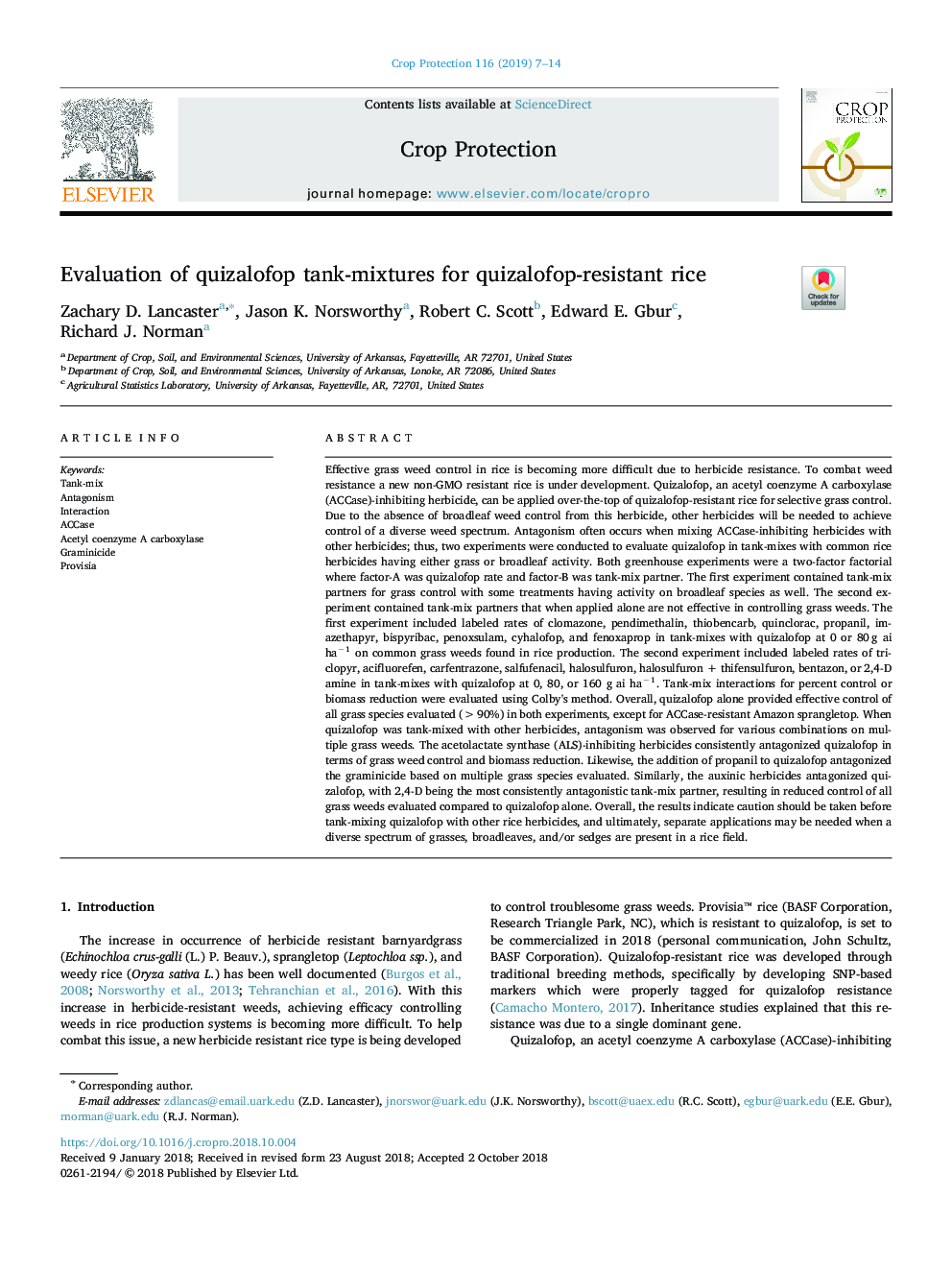| کد مقاله | کد نشریه | سال انتشار | مقاله انگلیسی | نسخه تمام متن |
|---|---|---|---|---|
| 11013004 | 1797617 | 2019 | 8 صفحه PDF | دانلود رایگان |
عنوان انگلیسی مقاله ISI
Evaluation of quizalofop tank-mixtures for quizalofop-resistant rice
دانلود مقاله + سفارش ترجمه
دانلود مقاله ISI انگلیسی
رایگان برای ایرانیان
کلمات کلیدی
موضوعات مرتبط
علوم زیستی و بیوفناوری
علوم کشاورزی و بیولوژیک
علوم زراعت و اصلاح نباتات
پیش نمایش صفحه اول مقاله

چکیده انگلیسی
Effective grass weed control in rice is becoming more difficult due to herbicide resistance. To combat weed resistance a new non-GMO resistant rice is under development. Quizalofop, an acetyl coenzyme A carboxylase (ACCase)-inhibiting herbicide, can be applied over-the-top of quizalofop-resistant rice for selective grass control. Due to the absence of broadleaf weed control from this herbicide, other herbicides will be needed to achieve control of a diverse weed spectrum. Antagonism often occurs when mixing ACCase-inhibiting herbicides with other herbicides; thus, two experiments were conducted to evaluate quizalofop in tank-mixes with common rice herbicides having either grass or broadleaf activity. Both greenhouse experiments were a two-factor factorial where factor-A was quizalofop rate and factor-B was tank-mix partner. The first experiment contained tank-mix partners for grass control with some treatments having activity on broadleaf species as well. The second experiment contained tank-mix partners that when applied alone are not effective in controlling grass weeds. The first experiment included labeled rates of clomazone, pendimethalin, thiobencarb, quinclorac, propanil, imazethapyr, bispyribac, penoxsulam, cyhalofop, and fenoxaprop in tank-mixes with quizalofop at 0 or 80â¯g ai haâ1 on common grass weeds found in rice production. The second experiment included labeled rates of triclopyr, acifluorefen, carfentrazone, salfufenacil, halosulfuron, halosulfuron + thifensulfuron, bentazon, or 2,4-D amine in tank-mixes with quizalofop at 0, 80, or 160 g ai haâ1. Tank-mix interactions for percent control or biomass reduction were evaluated using Colby's method. Overall, quizalofop alone provided effective control of all grass species evaluated (>90%) in both experiments, except for ACCase-resistant Amazon sprangletop. When quizalofop was tank-mixed with other herbicides, antagonism was observed for various combinations on multiple grass weeds. The acetolactate synthase (ALS)-inhibiting herbicides consistently antagonized quizalofop in terms of grass weed control and biomass reduction. Likewise, the addition of propanil to quizalofop antagonized the graminicide based on multiple grass species evaluated. Similarly, the auxinic herbicides antagonized quizalofop, with 2,4-D being the most consistently antagonistic tank-mix partner, resulting in reduced control of all grass weeds evaluated compared to quizalofop alone. Overall, the results indicate caution should be taken before tank-mixing quizalofop with other rice herbicides, and ultimately, separate applications may be needed when a diverse spectrum of grasses, broadleaves, and/or sedges are present in a rice field.
ناشر
Database: Elsevier - ScienceDirect (ساینس دایرکت)
Journal: Crop Protection - Volume 116, February 2019, Pages 7-14
Journal: Crop Protection - Volume 116, February 2019, Pages 7-14
نویسندگان
Zachary D. Lancaster, Jason K. Norsworthy, Robert C. Scott, Edward E. Gbur, Richard J. Norman,